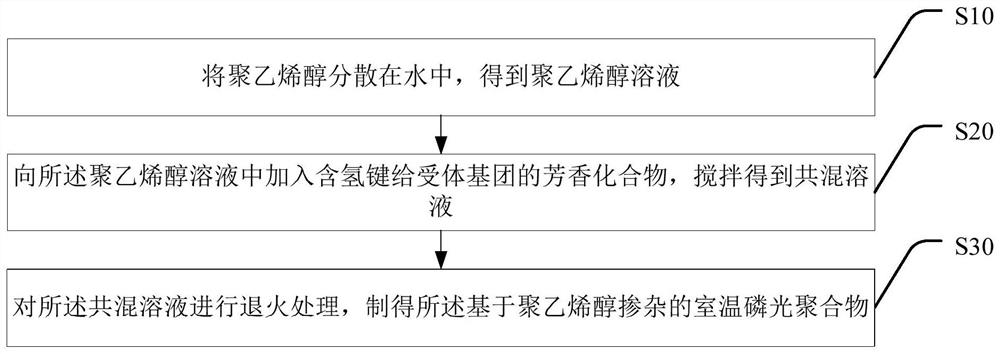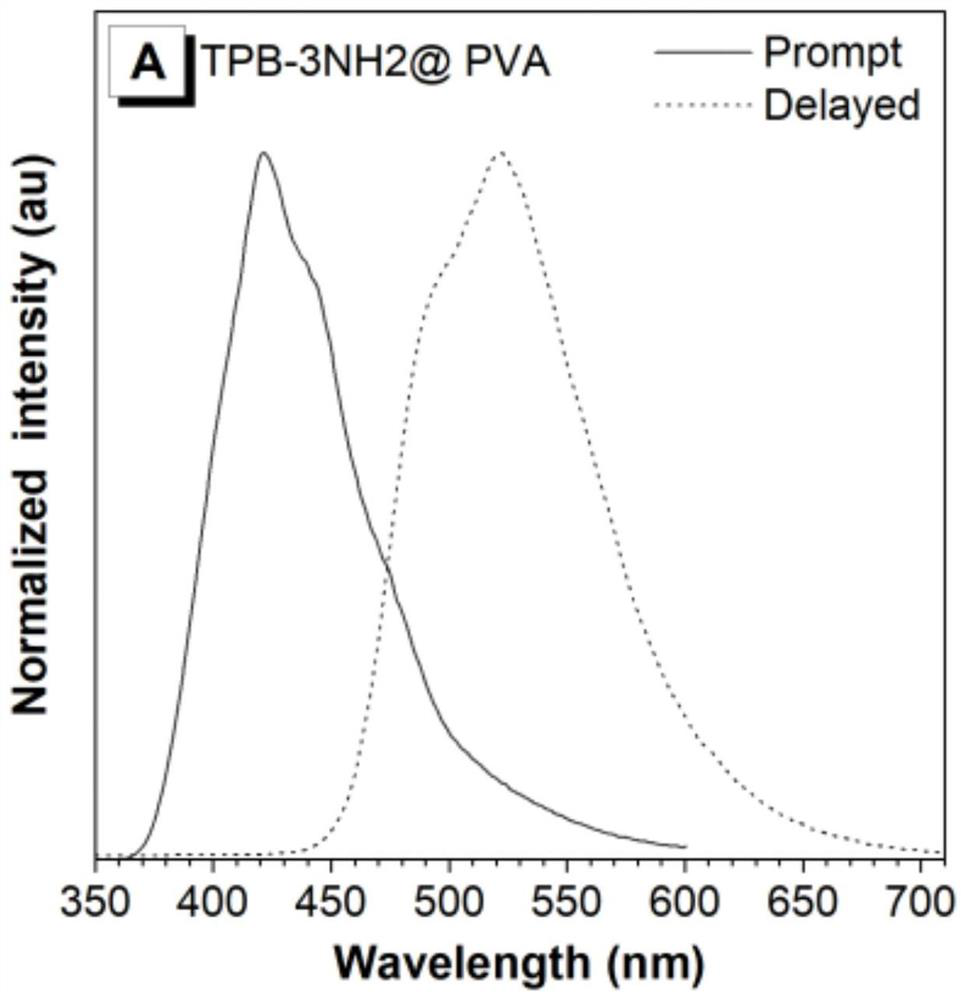Room-temperature phosphorescent polymer based on polyvinyl alcohol doping as well as preparation method and application of room-temperature phosphorescent polymer
A technology of polyvinyl alcohol doping and room temperature phosphorescence, applied in chemical instruments and methods, luminescent materials, etc., can solve the problems of poor luminescence performance and expensive preparation costs, etc.
- Summary
- Abstract
- Description
- Claims
- Application Information
AI Technical Summary
Problems solved by technology
Method used
Image
Examples
Embodiment 1
[0046]Weigh 450mg of PVA and dissolve it in pure water (15mL), take 2ml of the solution, add TPB-3NH2 (1mg), stir vigorously overnight, the next day, take 20μL of the mixture and add it dropwise to the quartz plate, volatilize slowly, and anneal at 80°C for 1h , to obtain an amorphous film T1.
[0047] The amorphous thin film T1 that present embodiment is made is carried out transient state and retardation spectrum test, and the result is as follows figure 2 shown. The figure shows that the prepared thin film T1 has fluorescent and phosphorescent properties. The fluorescence emission maximum is at 422nm, and the phosphorescence maximum emission is at 519nm.
Embodiment 2
[0049] Weigh 450mg of PVA and dissolve it in pure water (15mL), take 2ml of the solution, add TPB-3COOH (1mg), stir vigorously overnight, and the next day, take 20μL of the mixture and add it dropwise to a quartz plate, slowly volatilize, and anneal at 80°C for 1h , to obtain an amorphous film T2.
[0050] The amorphous thin film T2 that present embodiment is made is carried out transient state and delay spectrum test, and the result is as follows image 3 shown. The figure shows that the prepared thin film T1 has fluorescent and phosphorescent properties. The fluorescence emission maximum is at 435nm, and the phosphorescence maximum emission is at 500nm.
Embodiment 3
[0052] Weigh 450mg of PVA and dissolve it in pure water (15mL), take 2ml of the solution, add TPB-3OH (1mg), stir vigorously overnight, and the next day, take 20μL of the mixture and add it dropwise on the quartz plate, slowly volatilize, and anneal at 80°C for 1h , to obtain an amorphous film T3.
[0053] The amorphous thin film T3 that present embodiment is made is carried out transient state and retardation spectrum test, and the result is as follows Figure 4 shown. The figure shows that the prepared thin film T1 has fluorescent and phosphorescent properties. The fluorescence emission maximum is at 385nm, and the phosphorescence maximum emission is at 500nm.
[0054] Further, the phosphorescence attenuation test was carried out on the amorphous films T1-T3 prepared in the present embodiment 1-embodiment 3, and the results were as follows Figure 5 As shown, the phosphorescence decay times of the amorphous films T1-T3 are respectively 1412ms, 1034ms, and 1647ms through e...
PUM
| Property | Measurement | Unit |
|---|---|---|
| concentration | aaaaa | aaaaa |
Abstract
Description
Claims
Application Information
 Login to View More
Login to View More - R&D
- Intellectual Property
- Life Sciences
- Materials
- Tech Scout
- Unparalleled Data Quality
- Higher Quality Content
- 60% Fewer Hallucinations
Browse by: Latest US Patents, China's latest patents, Technical Efficacy Thesaurus, Application Domain, Technology Topic, Popular Technical Reports.
© 2025 PatSnap. All rights reserved.Legal|Privacy policy|Modern Slavery Act Transparency Statement|Sitemap|About US| Contact US: help@patsnap.com



